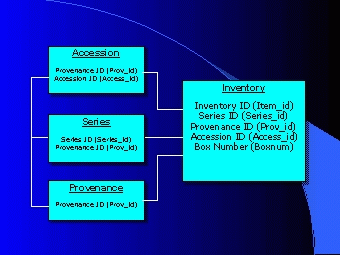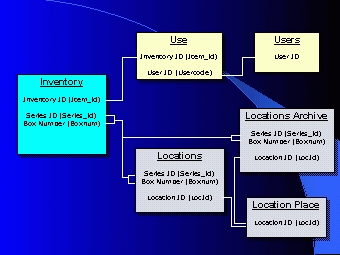Heritage Documentation Management System (HDMS)
The Heritage Documentation Management System has been developed over a ten year period, and is used by the Centre to manage its archival and artefactual documentation projects. A recent development includes an automated HTML and EAD finding aid generator to make the Web publication of guides to collections easier. (See HDMS Finding Aids)
The logical structure of the HDMS, as illustrated in the diagrams below, is based around:
- capturing key information about the collection as it is transferred in the Accession table;
- capturing information about the records in the Series and Inventory table;
- capturing information about the records creators and/or custodians in the Provenance; and
- managing ongoing storage, access and use in the Locations module.

Fig 1: Logical Structure of the HDMS ASPI Tables

Fig 2: Logical Structure of the HDMS Locations Module
For more information on the HDMS, its conceptual underpinnings and development plans, please explore the following papers:
- Kylie Percival, Francesca Zilio and Helen Morgan, 'Database Applications in an Imperfect World: The Necessity and Charm of Compromise', Archives and Manuscripts, vol. 28 no. 2, November 2000, pp 30-44.
- 'Application of New Archival Theory and Database Technologies', presentation at Archives and Reform - Preparing for Tomorrow, Australian Society of Archivists 1997 National Conference, Adelaide, 24-26 July 1997.
- 'The Generation Victoria Story', paper presented at Archives at the Centre, Australian Society of Archivists 1996 National Conference, Alice Springs, 24-25 May 1996.